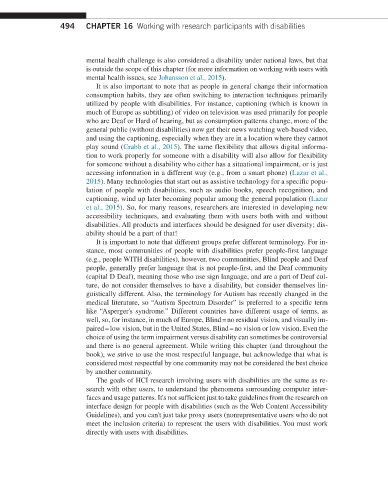Page 501 -
P. 501
494 CHAPTER 16 Working with research participants with disabilities
mental health challenge is also considered a disability under national laws, but that
is outside the scope of this chapter (for more information on working with users with
mental health issues, see Johansson et al., 2015).
It is also important to note that as people in general change their information
consumption habits, they are often switching to interaction techniques primarily
utilized by people with disabilities. For instance, captioning (which is known in
much of Europe as subtitling) of video on television was used primarily for people
who are Deaf or Hard of hearing, but as consumption patterns change, more of the
general public (without disabilities) now get their news watching web-based video,
and using the captioning, especially when they are in a location where they cannot
play sound (Crabb et al., 2015). The same flexibility that allows digital informa-
tion to work properly for someone with a disability will also allow for flexibility
for someone without a disability who either has a situational impairment, or is just
accessing information in a different way (e.g., from a smart phone) (Lazar et al.,
2015). Many technologies that start out as assistive technology for a specific popu-
lation of people with disabilities, such as audio books, speech recognition, and
captioning, wind up later becoming popular among the general population (Lazar
et al., 2015). So, for many reasons, researchers are interested in developing new
accessibility techniques, and evaluating them with users both with and without
disabilities. All products and interfaces should be designed for user diversity; dis-
ability should be a part of that!
It is important to note that different groups prefer different terminology. For in-
stance, most communities of people with disabilities prefer people-first language
(e.g., people WITH disabilities), however, two communities, Blind people and Deaf
people, generally prefer language that is not people-first, and the Deaf community
(capital D Deaf), meaning those who use sign language, and are a part of Deaf cul-
ture, do not consider themselves to have a disability, but consider themselves lin-
guistically different. Also, the terminology for Autism has recently changed in the
medical literature, so “Autism Spectrum Disorder” is preferred to a specific term
like “Asperger's syndrome.” Different countries have different usage of terms, as
well, so, for instance, in much of Europe, Blind = no residual vision, and visually im-
paired = low vision, but in the United States, Blind = no vision or low vision. Even the
choice of using the term impairment versus disability can sometimes be controversial
and there is no general agreement. While writing this chapter (and throughout the
book), we strive to use the most respectful language, but acknowledge that what is
considered most respectful by one community may not be considered the best choice
by another community.
The goals of HCI research involving users with disabilities are the same as re-
search with other users, to understand the phenomena surrounding computer inter-
faces and usage patterns. It's not sufficient just to take guidelines from the research on
interface design for people with disabilities (such as the Web Content Accessibility
Guidelines), and you can't just take proxy users (nonrepresentative users who do not
meet the inclusion criteria) to represent the users with disabilities. You must work
directly with users with disabilities.

